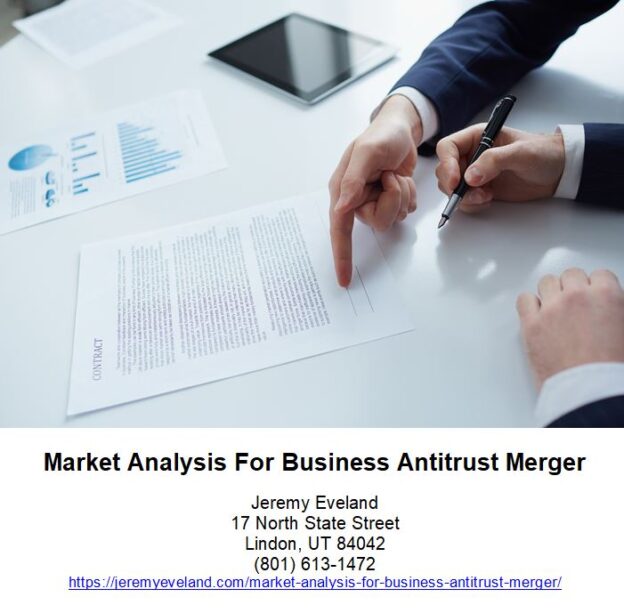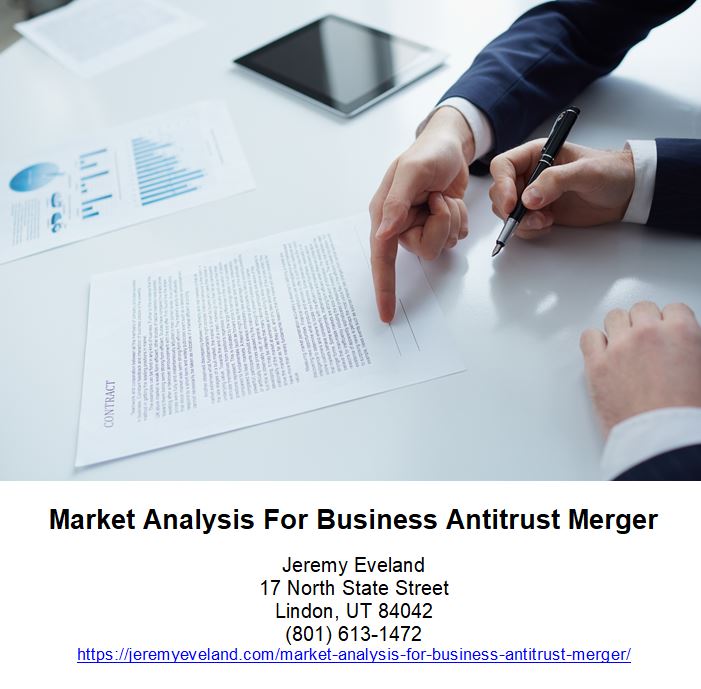The law bars mergers that have potential harmful effects in a “line of commerce” in a “section of the country.” In practical terms, this means the agency will examine the businesses of the merging parties both in terms of what they sell (a product dimension) and where they sell it (a geographic dimension).
Market analysis starts with the products or services of the two merging companies. In the case of a horizontal merger, the companies have products or services that customers see as close substitutes. Before the merger, the two companies may have offered customers lower prices or better service to gain sales from one another. After the merger, that beneficial competition will be gone as the merged firm will make business decisions regarding the products or services of both companies. The loss of competition may not matter if a sufficient number of customers are likely to switch to products or services sold by other companies if the merged company tried to increase its prices. In that case, customers view the products of other rivals to be good substitutes for the products of the merging firms and the merger may not affect adversely the competitive process with higher prices, lower quality, or reduced innovation if there is a sufficient number of competitive choices after the deal.
In the most general terms, a product market in an antitrust investigation consists of all goods or services that buyers view as close substitutes. That means if the price of one product goes up, and in response consumers switch to buying a different product so that the price increase is not profitable, those two products may be in the same product market because consumers will substitute those products based on changes in relative prices. But if the price goes up and consumers do not switch to different products, then other products may not be in the product market for purposes of assessing a merger’s effect on competition.
In some investigations, the agencies are able to explore customers’ product preferences using actual prices and sales data. For instance, when the FTC challenged the merger of Staples and Office Depot, the court relied on pricing data to conclude that consumers preferred to shop at an office superstore to buy a wide variety of supplies, even though those same products could be purchased at a combination of different retailers. The product market in that case was the retail sale of office supplies by office supply superstores. In the majority of cases, however, the agency relies on other types of evidence, obtained primarily from customers and from business documents. For instance, evidence that customers highly value certain product attributes may limit their willingness to substitute other products in the event of a price increase. In the FTC’s review of a merger between two ready-mix concrete suppliers, customers believed that asphalt and other building materials were not good substitutes for ready-mix concrete, which is pliable when freshly mixed and has superior strength and permanence after it hardens. Based on this and other evidence, the product market was limited to ready-mix concrete.
A geographic market in an antitrust investigation is that area where customers would likely turn to buy the goods or services in the product market. Competition may be limited to a small area because of the time or expense involved in buying a lower-cost product elsewhere. For instance, in a merger between two companies providing outpatient dialysis services, the FTC found that most patients were willing to travel no more than 30 miles or 30 minutes to receive kidney dialysis treatment. The FTC identified 35 local geographic markets in which to examine the effects of that merger. The FTC often examines local geographic markets when reviewing mergers in retail markets, such as supermarkets, pharmacies, or funeral homes, or in service markets, such as health care.
Shipping patterns are often a primary factor in determining the scope of a geographic market for intermediate or finished goods. In some industries, companies can ship products worldwide from a single manufacturing facility. For other products where service is an important element of competition or transportation costs are high compared with the value of the product, markets are more localized, perhaps a country or region of the country. For example, when examining the market for industrial gases, the FTC found that the cost of transporting liquid oxygen and liquid nitrogen limited customers to sources within 150 to 200 miles of their business.
Premerger Notification and the Merger Review Process
Under the Hart-Scott-Rodino (HSR) Act, parties to certain large mergers and acquisitions must file premerger notification and wait for government review. The parties may not close their deal until the waiting period outlined in the HSR Act has passed, or the government has granted early termination of the waiting period. The FTC administers the premerger notification program, and its staff members answer questions and maintain a website with helpful information about how and when to file. The FTC also provides daily updates of deals that receive early termination.
Steps in the Merger Review Process
We will look at each of the steps in a merger review process below.
Step One: Filing Notice of a Proposed Deal
Not all mergers or acquisitions require a premerger filing. Generally, the deal must first have a minimum value and the parties must be a minimum size. These filing thresholds are updated annually. In addition, some stock or asset purchases are exempt, as are purchases of some types of real property. For further help with filing requirements, see the FTC’s Guides to the Premerger Notification Program. There is a filing fee for premerger filings.
For most transactions requiring a filing, both buyer and seller must file forms and provide data about the industry and their own businesses. Once the filing is complete, the parties must wait 30 days (15 days in the case of a cash tender offer or a bankruptcy) or until the agencies grant early termination of the waiting period before they can consummate the deal.
Step Two: Clearance to One Antitrust Agency
Parties proposing a deal file with both the FTC and DOJ, but only one antitrust agency will review the proposed merger. Staff from the FTC and DOJ consult and the matter is “cleared” to one agency or the other for review (this is known as the “clearance process”). Once clearance is granted, the investigating agency can obtain non-public information from various sources, including the parties to the deal or other industry participants.
Step Three: Waiting Period Expires or Agency Issues Second Request
After a preliminary review of the premerger filing, the agency can:
• terminate the waiting period prior to the end of the waiting period (grant Early Termination or “ET”);
• allow the initial waiting period to expire; or
• issue a Request for Additional Information (“Second Request”) to each party, asking for more information.
If the waiting period expires or is terminated, the parties are free to close their deal. If the agency has determined that it needs more information to assess the proposed deal, it sends both parties a Second Request. This extends the waiting period and prevents the companies from completing their deal until they have “substantially complied” with the Second Request and observed a second waiting period. A Second Request typically asks for business documents and data that will inform the agency about the company’s products or services, market conditions where the company does business, and the likely competitive effects of the merger. The agency may conduct interviews (either informally or by sworn testimony) of company personnel or others with knowledge about the industry.
Step Four: Parties Substantially Comply with the Second Requests
Typically, once both companies have substantially complied with the Second Request, the agency has an additional 30 days to review the materials and take action, if necessary. (In the case of a cash tender offer or bankruptcy, the agency has 10 days to complete its review and the time begins to run as soon as the buyer has substantially complied.) The length of time for this phase of review may be extended by agreement between the parties and the government in an effort to resolve any remaining issues without litigation.
Step Five: The Waiting Period Expires or the Agency Challenges the Deal
The potential outcomes at this stage are:
• close the investigation and let the deal go forward unchallenged;
• enter into a negotiated consent agreement with the companies that includes provisions that will restore competition; or
• seek to stop the entire transaction by filing for a preliminary injunction in federal court pending an administrative trial on the merits.
Unless the agency takes some action that results in a court order stopping the merger, the parties can close their deal at the end of the waiting period. Sometimes, the parties will abandon their plans once they learn that the agency is likely to challenge the proposed merger.
In many merger investigations, the potential for competitive harm is not a result of the transaction as a whole, but rather occurs only in certain lines of business. One example would be when a buyer competes in a limited line of products with the company it seeks to buy. In this situation the parties may resolve the concerns about the merger by agreeing to sell off the particular overlapping business unit or assets of one of the merging parties, but then complete the remainder of the merger as proposed. This allows the procompetitive benefits of the merger to be realized without creating the potential for anticompetitive harm. Many merger challenges are resolved with a consent agreement between the agency and the merging parties.
Areas We Serve
We serve individuals and businesses in the following locations:
Salt Lake City Utah
West Valley City Utah
Provo Utah
West Jordan Utah
Orem Utah
Sandy Utah
Ogden Utah
St. George Utah
Layton Utah
South Jordan Utah
Lehi Utah
Millcreek Utah
Taylorsville Utah
Logan Utah
Murray Utah
Draper Utah
Bountiful Utah
Riverton Utah
Herriman Utah
Spanish Fork Utah
Roy Utah
Pleasant Grove Utah
Kearns Utah
Tooele Utah
Cottonwood Heights Utah
Midvale Utah
Springville Utah
Eagle Mountain Utah
Cedar City Utah
Kaysville Utah
Clearfield Utah
Holladay Utah
American Fork Utah
Syracuse Utah
Saratoga Springs Utah
Magna Utah
Washington Utah
South Salt Lake Utah
Farmington Utah
Clinton Utah
North Salt Lake Utah
Payson Utah
North Ogden Utah
Brigham City Utah
Highland Utah
Centerville Utah
Hurricane Utah
South Ogden Utah
Heber Utah
West Haven Utah
Bluffdale Utah
Santaquin Utah
Smithfield Utah
Woods Cross Utah
Grantsville Utah
Lindon Utah
North Logan Utah
West Point Utah
Vernal Utah
Alpine Utah
Cedar Hills Utah
Pleasant View Utah
Mapleton Utah
Stansbury Par Utah
Washington Terrace Utah
Riverdale Utah
Hooper Utah
Tremonton Utah
Ivins Utah
Park City Utah
Price Utah
Hyrum Utah
Summit Park Utah
Salem Utah
Richfield Utah
Santa Clara Utah
Providence Utah
South Weber Utah
Vineyard Utah
Ephraim Utah
Roosevelt Utah
Farr West Utah
Plain City Utah
Nibley Utah
Enoch Utah
Harrisville Utah
Snyderville Utah
Fruit Heights Utah
Nephi Utah
White City Utah
West Bountiful Utah
Sunset Utah
Moab Utah
Midway Utah
Perry Utah
Kanab Utah
Hyde Park Utah
Silver Summit Utah
La Verkin Utah
Morgan Utah
Market Analysis For Business Antitrust Merger Consultation
When you need help with a Market Analysis For Business Antitrust Merger call Jeremy D. Eveland, MBA, JD (801) 613-1472 for a consultation.
Jeremy Eveland
17 North State Street
Lindon UT 84042
(801) 613-1472
Related Posts
Using Disclaimers In Estate Planning
Business Succession Lawyer Spanish Fork Utah
Corporate Attorney St. George Utah
Business Strategy and Consulting
Business Succession Lawyer Roy Utah
Business Lawyer St George Utah
Estate Planning Lawyer Ogden Utah

